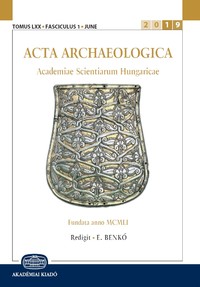Environmental historical analysis of the Sarmatian and Gepids settlement of Rákóczifalva
Environmental historical analysis of the Sarmatian and Gepids settlement of Rákóczifalva
Author(s): Beáta Tugya, Katalin Náfrádi, Sándor Gulyás, Tünde Törőcsik, Balázs Pál Sümegi, Péter Pomázi, Pál SümegiSubject(s): Archaeology, Ancient World
Published by: Akadémiai Kiadó
Keywords: Rákóczifalva; Sarmatian; Late Sarmatian; Gepids; geoarchaeology; pollen analysis; macrobotanical analysis; archaeozoology; bone anvil
Summary/Abstract: We present the results of the environmental historical and geoarchaeological analysis of Rákóczifalva-Bagi- földek and Rákóczifalva-Rokkant-földek archeological sites in Jász-Nagykun-Szolnok County. They were discovered in the course of several hectares of archaeological excavations related to the Roman Age and Migration Period, especially the Sarmatian and the Gepids era. A significant number of Gepids sites and finds were found in both the investigated areas and the wider area of the site, in the middle reach of the Tisza valley. So the geoarchaeological and environmental historical analysis of the Sarmatian and Late-Sarmatian and Gepids sites in Rákóczifalva can also provide a model for the settling strategy and lifestyle of the Sarmatian and Gepids communities. The purpose of our work is to present how geoarchaeological and environmental historical factors impacted local settling and lifestyles in the Gepids communities and Sarmatian-Late Sarmatian communities as well during the Roman Age and the Migration Period. In addition, to demonstrate the relationship of the Sarmatian and Gepids communities and their environment in the Rákóczifalva site compared to other Gepids and Sarmatian and Late Sarmatian communities in the Great Hungarian Plain. Based on the number of objects containing animal bones and the amount of bones found in them, we can reconstruct considerable settling in the Celtic, Sarmatian, Gepids, Avar and Arpadian periods. The number of objects from the Linear Pottery culture (Great Hungarian Plain) and the Bodrogkeresztúr culture is high; however, the number of animal bones is low. On the basis of the bones discovered, we can count on a smaller settlement during the Tiszapolgár culture, the Hunyadihalom group, the Halomíros culture, the Gava culture and during the Scythians period. In this paper, we present the results of the Sarmatian, Late Sarmatian and the Gepid findings since the largest number of animal bones (except the Avar period) turned up from these periods. Our aim was to compare the animal husbandry, meat consumption and hunting habits of the Oriental origin Sarmatians and the Germanic Gepids communities. Bone artefacts and bone anvils have been found in the archaeological material of both ethnic groups.
Journal: Acta Archaeologica Academiae Scientiarum Hungaricae
- Issue Year: 71/2020
- Issue No: 1
- Page Range: 101-156
- Page Count: 52
- Language: English

